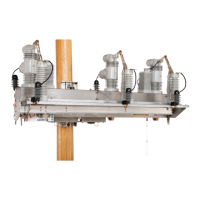The Sequence Coordination element maintains proper coordination between the
IntelliRupter fault interrupter and downstream reclosers. When a fault is cleared by
a downstream recloser, the IntelliRupter fault interrupter shifts to a slower curve for
subsequent fault testing before the Close operation. When the Sequence Coordination
mode is used, TCC values must be entered for Direction 1 and Direction 2. Settings are
similar to those for the Initial Trip settings. See Figure 44.
TCCs for Coordination
Figure 44. The Setup>Protection>General Profile 1>Direction 1 Current>TCCs for
Coordination screen.
Coordination Mode
Settings are: None, Sequence Coordination, or Communication Enhanced
Coordination. When Sequence Coordination mode or Communication Enhanced
Coordination mode is used, TCC values must be entered for Direction 1 and/or
Direction 2. Settings are similar to those for the Initial Trip settings.
Sequence Coordination
When Sequence Coordination mode is selected, Initial Trip TCCs are deactivated and
Sequence Coordination TCCs are activated after Initial Trip TCCs have been timing for
an overcurrent event that doesn’t result in a trip command. This transition occurs when
Initial Trip overcurrent elements reset, which means Initial Trip TCC reset methods
(E/M or D/T mode), and their related time value settings (Reset Time value), have no
effect on this transition.
S&C Instruction Sheet 766-530 67
Protection Setup

